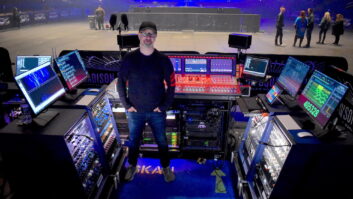Film sound professionals are always trying to outdo themselves. But, during the making of the soundtrack for The Adventures of Rocky and Bullwinkle, supervising sound editor Bruce Stambler (Batman Forever, Clear and Present Danger, The Fugitive) and sound designer Tim Walston (Chain of Fools, Clay Pigeons, The Mod Squad) didn’t have to spend any time thinking up new challenges. There were plenty inherent in the concept itself: After years of being trapped in a two-dimensional animated world, our favorite spies, Boris and Natasha, have broken a secret code that allows them into the real world. Rocky and Bullwinkle, who remain CGI-created cartoons courtesy of Industrial Light & Magic, must figure out how to foil the dastardly duo across the dimensions, and the Internet.
Described as an “irreverent live-action/animated comedy adventure” and based on Jay Ward’s classic cartoon, the Universal Pictures/Tribeca Productions film features Robert DeNiro as Fearless Leader, Jason Alexander as the evil Boris Badenov and Renee Russo as the seductress Natasha Fatale.
Slated for a June 30 release, R&B was in the process of predubbing on the Neve DFC at Warner Bros. Stage 6 in Burbank when we spoke with Stambler and Walston. Also on the team were mixers Mike Caspar, dialog; Frank Montoya, sound effects; and Greg Watkins, music.
So how do you make live action work with animation? Stambler, an oscar nominee five straight years who won a statue in 1996 for Best Sound Effects Editing on The Ghost and the Darkness, says, “Sometimes, in the same frame, it’s right-in-front-of-you reality vs. these two animated characters. So you’re dealing with three entities: first, real, live-action characters; then Boris and Natasha, who were cartoon characters but are now live-action people; and finally, Rocky and Bullwinkle, who are completely animated. For me, the main focus with this kind of venue is that you want it to be fun.
“For example, there’s a scene where Boris and Natasha are throwing dynamite sticks at Rocky and Bullwinkle and the star of the movie, Karen Sympathy. Karen’s driving in her Volkswagen convertible, and they’re throwing dynamite sticks at the car, which then goes off a cliff. Reality-wise it’s explosions and possibly blowing up the car, but I don’t play it like that because that would be too scary-we’re not doing something like Clear and Present Danger here. Instead, it’s about making the dynamite somewhat fun in a non-threatening way. So I did a full-on cartoon crash, and even though it’s a reality visual-car off the cliff, the fireball and crashing-I did all cartoon effects: boings and swishes and things vibrating by.
“We’re doing that throughout the whole movie,” he continues. “A live-action character ducks down, and we put in a whistle or a whoosh for her. We’re not making light of the film, just trying to make it as much fun as we can from the point of view of sound. It’s definitely a different way of working. And it can be difficult to do, because sometimes when you put in comedy effects with reality-based visuals, it can cheapen the effect. That’s something I’m very conscious of, because generally I’m for the non-obvious. But in this case you’ve got to have comedy, and, ‘cartoon effects,’ so it was our job to make them work well.”
“I cut the car crash scene once with very realistic elements and then we had to go back and provide a different angle,” adds Walston. “It was definitely a challenge to make a fireball funny! I used a ton of stuff from various different sources to portray the action but also to keep it lighthearted.
“I think that cartoons and cartoon-like sound effects are really kind ofembedded in the pop culture,” Walston continues. “It’s almost like a language. People have a tremendous familiarity with the traditional cartoon sounds, and anything that sounds similar will kind of fit right in, kind of go in through the back door, as sound often does. When you use a sound appropriately, it fits with what we’re used to from what we grew up with. If you use the wrong sound, or use it the wrong way, then it doesn’t work.”
Stambler and Walston couldn’t give too much away, but they hinted at a big ending sequence filled with a combination of CGI, electronic effects and Internet references. And Walston did admit that one of his secret weapons for Rocky’s flying sounds was a vacuum cleaner.
“It’s not the only element,” he laughs, “but I used an old cannister model with the motor in the closet. I processed some of the air elements, and it added the one thing I was missing.”







